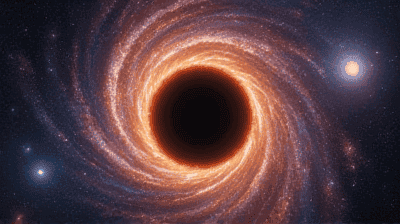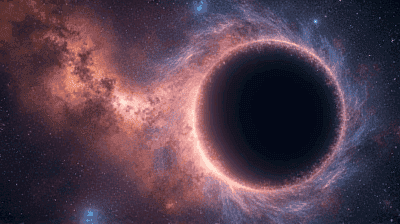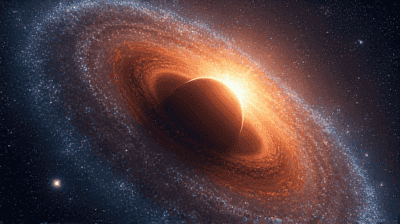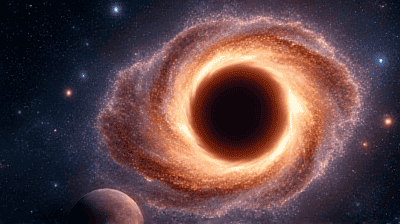
Black holes have long intrigued scientists and astronomy enthusiasts alike. These mysterious entities—particularly supermassive black holes located at the centers of galaxies—are not just fascinating cosmic objects; they play a crucial role in shaping the structures and dynamics of entire galaxies. From their formation and growth to their influence on star formation and galactic evolution, supermassive black holes hold many secrets about the universe.
Understanding Black Holes
What is a Black Hole?
A black hole is defined as a region in space with a gravitational pull so strong that nothing, not even light, can escape from it. The boundary surrounding a black hole is known as the event horizon. When any matter crosses this boundary, it cannot return to the observable universe, leading to the black hole's "black" appearance.
Types of Black Holes
Black holes can be classified based on their mass into three primary categories:
Stellar Black Holes:
- Formed from the gravitational collapse of massive stars after they exhaust their nuclear fuel.
- Typically range in mass from about three to several tens of solar masses.
Supermassive Black Holes:
- Found at the centers of most galaxies, including our Milky Way.
- Can have masses ranging from millions to billions of solar masses.
Intermediate Black Holes:
- A still-mysterious category believed to lie between stellar and supermassive black holes, typically having masses from hundreds to thousands of solar masses.
The Event Horizon and Singularity
Each black hole features an event horizon, which is a boundary beyond which nothing can escape. Inside the event horizon resides the singularity, a point of infinite density where the laws of physics as we know them cease to function. The nature of singularities and what lies beyond event horizons are still subjects of intense study and debate among physicists.
The Formation of Supermassive Black Holes

Theories of Formation
While the formation of stellar black holes is relatively straightforward, the origins of supermassive black holes are less understood. Several leading theories have been proposed to explain how these massive entities form:
Direct Collapse:
- In this model, massive clouds of gas can collapse directly into a supermassive black hole without forming stars first. This process may occur in the early universe, where dense regions of gas cool rapidly, allowing for direct gravitational collapse.
Merging of Black Holes:
- Another theory suggests that small black holes can merge over time, gradually growing into supermassive black holes. This merging process can happen in regions of high star density, such as the centers of galaxies, where gravitational interactions can bring black holes close enough to collide.
Growth from Seeds:
- Some scientists propose that supermassive black holes grow from smaller seeds, such as stellar black holes or the remnants of early stars. These seeds can acquire mass by accreting gas and dust over billions of years and merging with other black holes.
Observational Evidence
Astronomers have gathered significant evidence supporting the existence of supermassive black holes. One of the primary indications is the motion of stars and gas around these black holes. By studying the orbits of stars in the vicinity of galactic centers, researchers can infer the presence of a massive, unseen object exerting gravitational influence.
For example, observations of the Milky Way's center revealed the presence of a supermassive black hole known as Sagittarius A*, which has a mass of approximately four million solar masses. Similar studies of other galaxies have provided evidence for supermassive black holes as well, including the famous black hole at the center of the M87 galaxy.
The Role of Supermassive Black Holes in Galaxy Formation
Galactic Centers and Star Formation
Supermassive black holes significantly influence the dynamics of their host galaxies. Their presence affects the motion of stars and gas within the galaxy, playing an essential role in regulating star formation.
Feedback Mechanisms:
- As matter falls toward a supermassive black hole, it forms an accretion disk—a rotating disk of gas and dust spiraling into the black hole. The intense gravitational forces and friction in the accretion disk can release significant amounts of energy in the form of radiation, including X-rays.
- This high-energy output can heat surrounding gas and expel material from the galactic center, effectively regulating star formation in the host galaxy. In fact, regions close to the black hole can become hostile to star formation due to the energetic feedback.
Starburst Galaxies:
- In some cases, supermassive black holes can trigger starbursts—periods of intense star formation due to the influx of gas into the galaxy. For example, the effects of interactions with other galaxies can funnel gas toward the black hole, leading to both an increase in star formation and growth of the black hole itself.
Spiral Structure and Dynamics
Supermassive black holes also play a role in shaping the overall structure of galaxies. Their gravitational pull influences the rotation patterns of stars and gas, contributing to the dynamics of galaxy formation.
Spiral Galaxies:
- In spiral galaxies, supermassive black holes can help maintain the stability of the spiral arms. As stars orbit around the black hole, their gravitational interactions can enhance the spiral structure, allowing the arms to persist over time.
Elliptical Galaxies:
- Supermassive black holes influence elliptical galaxies as well. The presence of a massive black hole can help define the overall dynamics of these galaxies, impacting how stars orbit one another and the distribution of stellar populations.
Observations of Supermassive Black Holes

Techniques and Instruments
Studying supermassive black holes requires advanced observational techniques and instruments. Astronomers use various methods to gather data about these colossal entities:
Spectroscopy:
- This technique involves analyzing the light emitted or absorbed by stars and gas near the black hole. By examining specific spectral lines, astronomers can determine the composition, density, and motion of materials in the vicinity of the black hole.
Adaptive Optics:
- Adaptive optics systems allow astronomers to correct for the distortions caused by Earth's atmosphere, enabling clearer images of distant galaxies and their central black holes. This technology is vital for precise measurements of stellar orbits near supermassive black holes.
Gravitational Wave Observations:
- The detection of gravitational waves from merging black holes has opened a new window for studying these cosmic giants. Observatories like LIGO and Virgo have detected ripples in spacetime, providing insights into black hole mergers and the population of black holes in the universe.
The Connection Between Supermassive Black Holes and Galaxy Evolution
Co-evolution of Black Holes and Galaxies
Supermassive black holes and their host galaxies exhibit a strong correlation in their evolution. Observational studies have shown that the masses of supermassive black holes are closely related to the properties of their host galaxies, such as the mass of the galaxy's bulge and its stellar population.
Black Hole Scaling Relations:
- The M-sigma relation is one of the key findings in this area. It describes a correlation between the mass of a supermassive black hole and the velocity dispersion of stars in the galaxy's bulge. This relationship indicates that more massive galaxies tend to harbor more massive black holes.
Galaxy Mergers:
- Galaxy mergers play a crucial role in the relationship between black holes and their hosts. When two galaxies merge, their black holes also come together, creating a supermassive black hole. This process can trigger episodes of rapid star formation and significantly influence the evolution of the newly formed galaxy.
The Impact on Cosmic Evolution
Supermassive black holes influence not only individual galaxies but also the larger structure of the universe. Their presence affects galaxy formation and clustering on cosmic scales.
Feedback on Galaxy Clusters:
- The energy output from supermassive black holes can regulate star formation across entire galaxy clusters. The interaction of black hole feedback with the surrounding gas can affect how clusters evolve over billions of years.
Growth of Cosmic Structures:
- The distribution and formation of galaxies and black holes ultimately impact the evolution of cosmic structures. Understanding supermassive black holes enhances our comprehension of the cosmos, including the development of galaxies and their interactions.
Mysteries and Current Research

Unanswered Questions
Despite significant advances in our understanding of supermassive black holes, many questions remain unanswered. Researchers continue to investigate the following mysteries:
Formation Pathways:
- How exactly do supermassive black holes form? While several theories exist, definitive answers are still elusive, prompting ongoing research into the early universe.
Growth Mechanics:
- What mechanisms allow supermassive black holes to grow to such enormous sizes? Clarifying how they acquire mass and the relationship between accretion and mergers remains an active area of study.
The Role of Dark Matter:
- How do supermassive black holes interact with dark matter, which constitutes a significant portion of the mass in the universe? Understanding this relationship could unveil important insights into cosmic structure.
The Nature of the Event Horizon:
- What happens at the event horizon? This philosophical question stretches to the limits of our understanding of black holes and the laws of physics. Ongoing research seeks to unravel the complexities of space-time in the presence of supermassive black holes.
Future Observations and Technologies
As technology continues to advance, astronomers are equipped with more sophisticated tools to explore the secrets of supermassive black holes:
Next-Gen Telescopes:
- The development of next-generation telescopes like the James Webb Space Telescope (JWST) is poised to revolutionize our approach to studying supermassive black holes. JWST will provide unique capabilities to observe the emission from galaxies and their central black holes in unprecedented detail.
Gravitational Wave Astronomy:
- The future of gravitational wave astronomy holds promise for providing new insights into black hole mergers, potentially unveiling hidden populations of black holes and their role in cosmic evolution.
Computational Simulations:
- Advances in supercomputing allow scientists to develop more precise simulations of black hole formation, evolution, and interactions, enhancing our understanding of their complex dynamics and influence on galaxies.
Conclusion
Supermassive black holes are not merely cosmic oddities; they are integral players in the grand narrative of the universe. From their formation and influence on galaxy dynamics to the profound implications for cosmic evolution, the study of supermassive black holes reveals the intricate connections that shape the cosmos.
As we continue to unlock the secrets of these enigmatic giants, we not only deepen our understanding of black holes themselves but also gain valuable insights into the nature of galaxies, dark matter, and the fundamental laws of physics. The journey of exploration and discovery surrounding supermassive black holes is just beginning, promising to reveal even more extraordinary secrets about the universe in the years to come.








